- 1 Important tips for crop rotation
- 2 Crop rotation impacts on yield
- 3 Crop rotation impacts on diseases
- 4 Crop rotation impacts on insects
- 5 Crop rotation impacts on fertility
- 6 Crop rotation impacts on moisture
- 7 Crop rotation impacts on weeds
- 8 Crop rotation impacts on other factors
- 9 Managing a rotation
- 10 Footnotes
Diversified crop rotations can have many benefits, especially with insect and disease management. A two- or three-year break between canola crops will significantly reduce viable spore counts for clubroot and blackleg in particular, making rotation an import step in managing these diseases. Rotation can also improve crop yields, increase soil organic carbon and reduce selection for weed resistance. Growers striving for diversity will include cereals, pulses, and oilseeds in their rotations. Some will also add perennial crops.
Important tips for crop rotation
Have at least one year, preferably two or three years, between canola crops. Canola seeded into canola stubble yields an average of 10 per cent to 20 per cent less than canola seeded into cereal or pulse stubble. In a rotation that has canola every second year, growers should increase the level of pest management diversity by using different modes of action for weed, disease and insect control. Fields with a short interval between canola crops should be scouted more frequently and intensively for pests and other rotation related issues. Keep accurate records to identify any trends towards increasing problems that may indicate a need to decrease canola frequency in the rotation.
Crop rotation impacts on yield
Canola seeded into canola stubble yields 10 per cent to 20 per cent less, in general, than canola seeded into cereal or pulse stubble. Farmer-reported yield data from provincial crop insurance records demonstrate this clearly and consistently in Alberta, Saskatchewan and Manitoba.
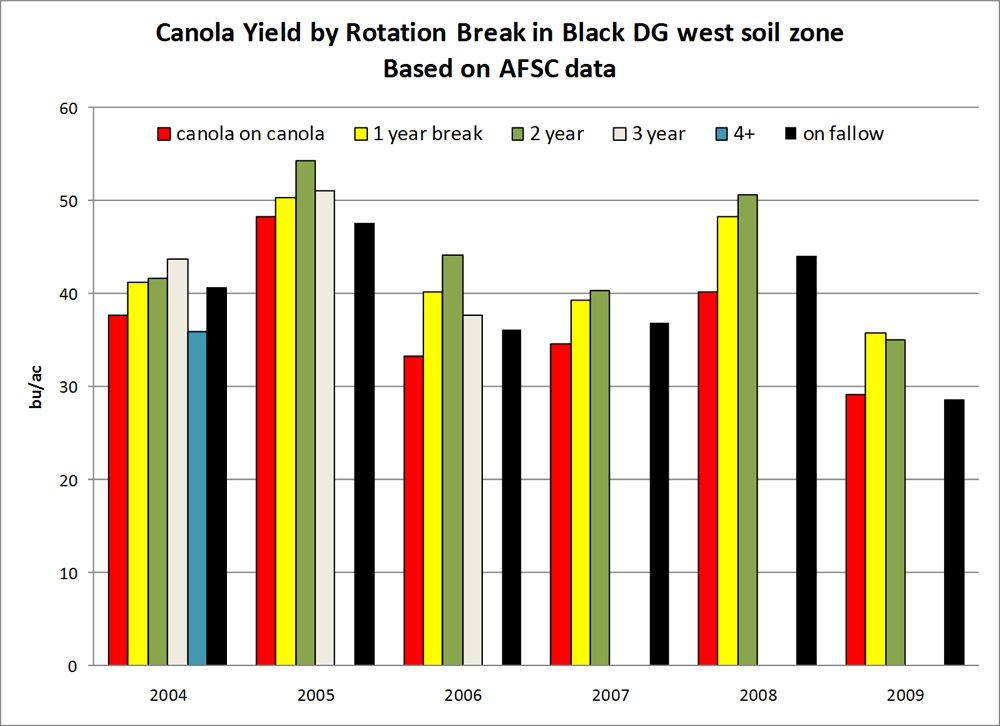
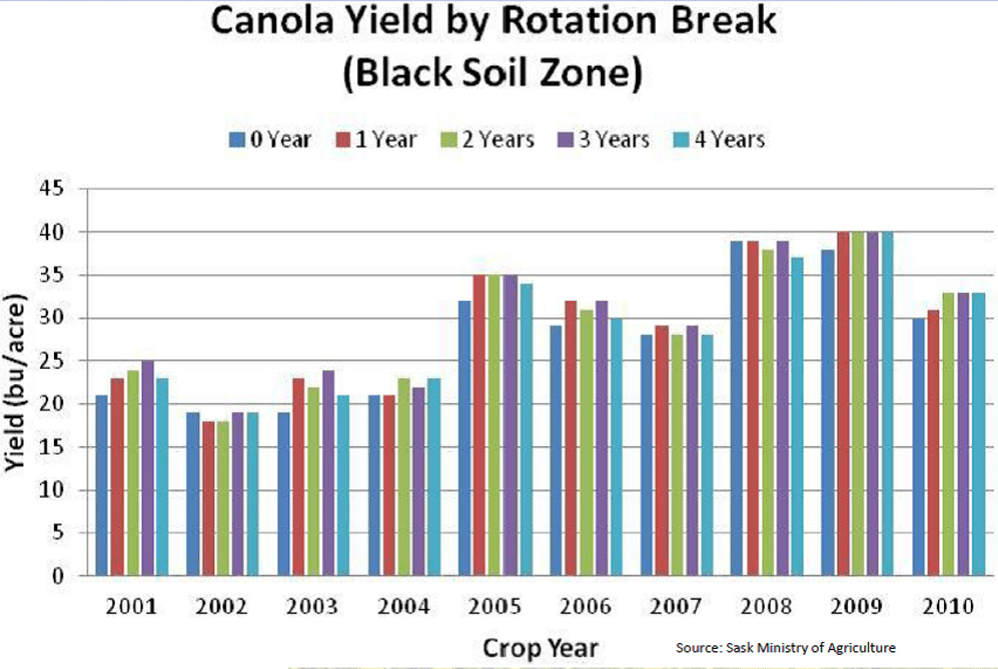
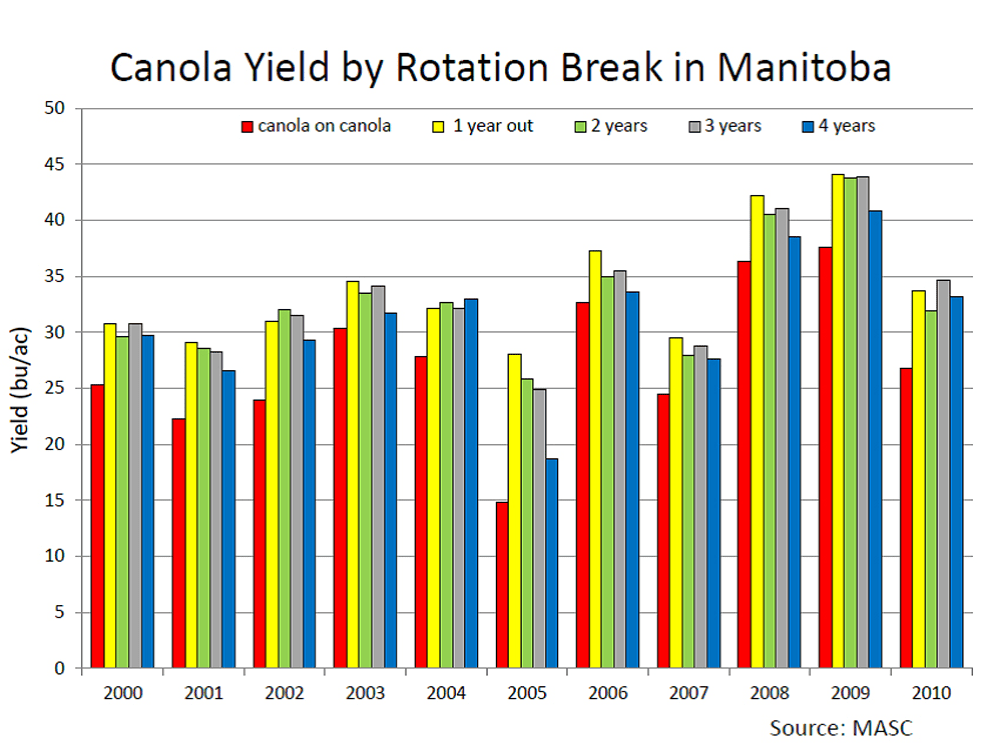
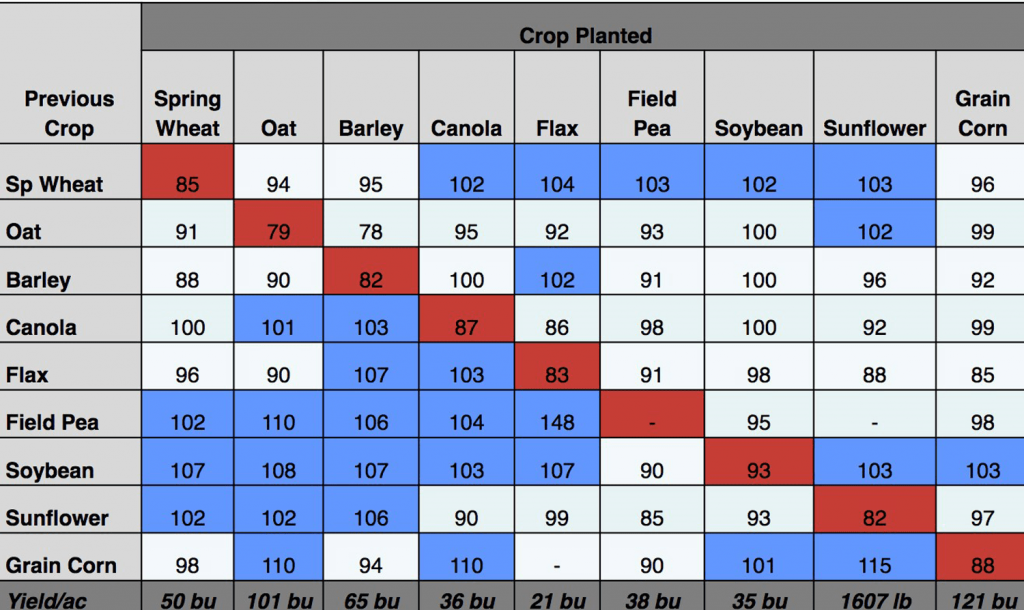
Additionally, this yield relationship can be demonstrated in replicated field trials. AAFCAgriculture and Agri-Food Canada is a department of the Government of Canada. More found that canola yield was shown to increase between 0.2 – 0.36 megagrams per hectare (3.5-6.5 bushels per acre) with every annual increase in the number of years between canola crops 1.
A number of factors may contribute to this drop in yield, either alone or in combination. Some of these include shifting or increasing disease, insect, or weed populations, declining soil fertility, and/or reduced available moisture throughout the typical canola rooting depth (unless rainfall is able to fully replenish it). When a crop is grown continuously, pest populations adapted to that crop will increase. Rotating crops tends to reduce pest build-up, especially immobile types that do not move in readily from nearby crops or on the wind.
Crop rotation impacts on diseases
Blackleg
Blackleg was the key reason behind the one-in-four rotation recommendation that was commonly promoted to growers a few decades ago. In the 1980s and 1990s, many leading canola varieties did not have strong resistance to blackleg and growers could see substantial yield losses if fields didn’t get at least a two-year break for blackleg to break down in the soil. All modern varieties have blackleg resistance, and while that resistance is beginning to be overcome in some locations for some varieties, genetic resistance is still an effective way for most growers to manage the disease in a tight canola rotationA high ratio of years growing canola compared to years not growing canola (a high frequency of years canola is grown out of the total number of years considered in a crop rotation). More. Long term, however, tight rotations of varieties with similar genetic resistance have over time selected for blackleg races that are more virulentA form which causes infection (and can result in a disease) More against that resistance.
Tight rotations can also cause seedling and root pathogens such as fusarium, pythium and rhizoctonia to build up in the soil.
Clubroot
Clubroot spore loads will increase with a tight rotation, especially if growers are not using clubroot resistant varieties. Research in Canada suggests that while a two-year break from canola can result in a 90 per cent reduction in spore loads in soil, disease severity and yield may not be improved. Even when using clubroot resistant varieties, both continuous canola and canola with a one-year break can have substantial yield losses, while canola grown between two, three, and four-year breaks may not have significant yield reductions. For that reason, a minimum of a two-year break is advised, with three and four-year breaks being preferable 2.
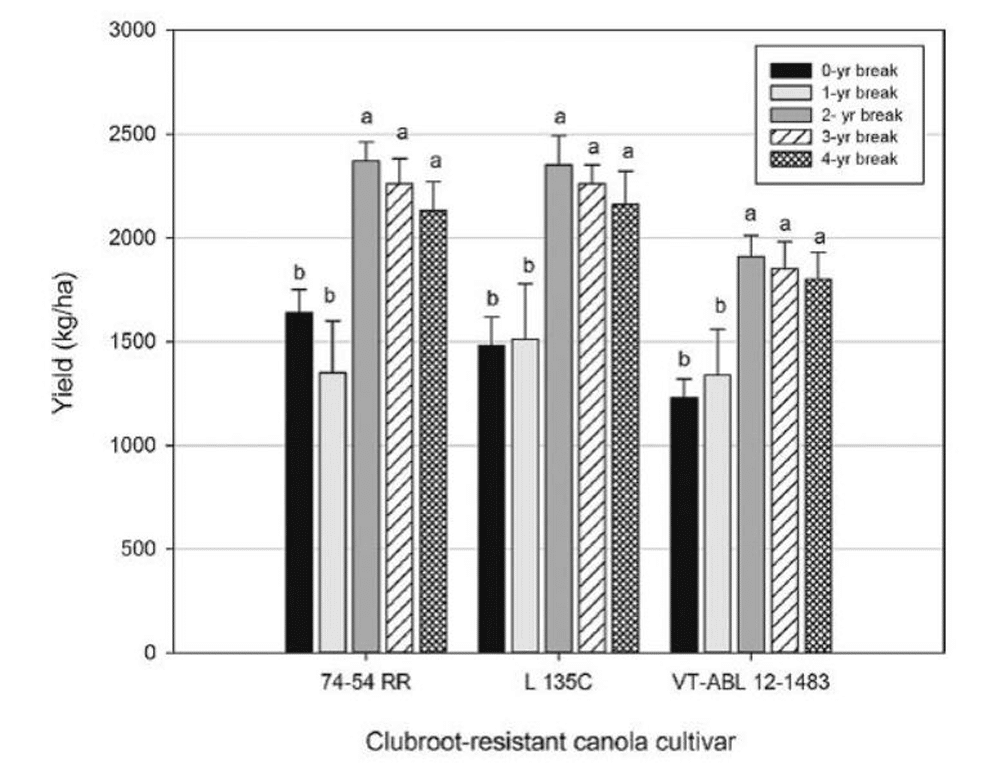
Sclerotinia
Sclerotinia stem rot risk may also increase with a shorter rotation (fewer non-canola crops grown between canola crops) on the same field. But with sclerotinia spores spreading so easily by wind and with 20 million (or more) acres of canola in Western Canada, rotation is not an effective management strategy for sclerotinia stem rot.
Other diseases
Rotation with cereals will reduce canola disease, provided that volunteer canola and cruciferousPlants belonging to the family Brassicaceae or (previously referred to as) Cruciferae. More weeds are controlled in the cereal break crops. Also, rotation with canola can reduce many cereal diseases such as common root rot, take-all and tan spot. Australian research has documented a significant reduction in take-all disease of wheat following canola, indicating that canola has a biofumigation effect.
Rotation with other crops will not necessarily reduce the disease risk. Yield reductions may occur when canola is grown on stubble of other crops susceptible to the same diseases. For example, broadleaf crops, especially those in the Brassica family (ex. mustard), can be hosts to diseases found in canola (Table 2).
Table 2. Guide to field selection for canola crops
Crop rotation impacts on insects
Root maggots (for which there are no insecticides available for in canola) have been shown to escalate quickly in fields of continuous canola. This coincides with reduced yields. Based on average canola prices, the yield losses quantified in one study were equivalent to $108-$140 per acre after only three years of continuous canola. The study also found that a one-year break did appear to make a significant reduction in losses from root maggots 3.
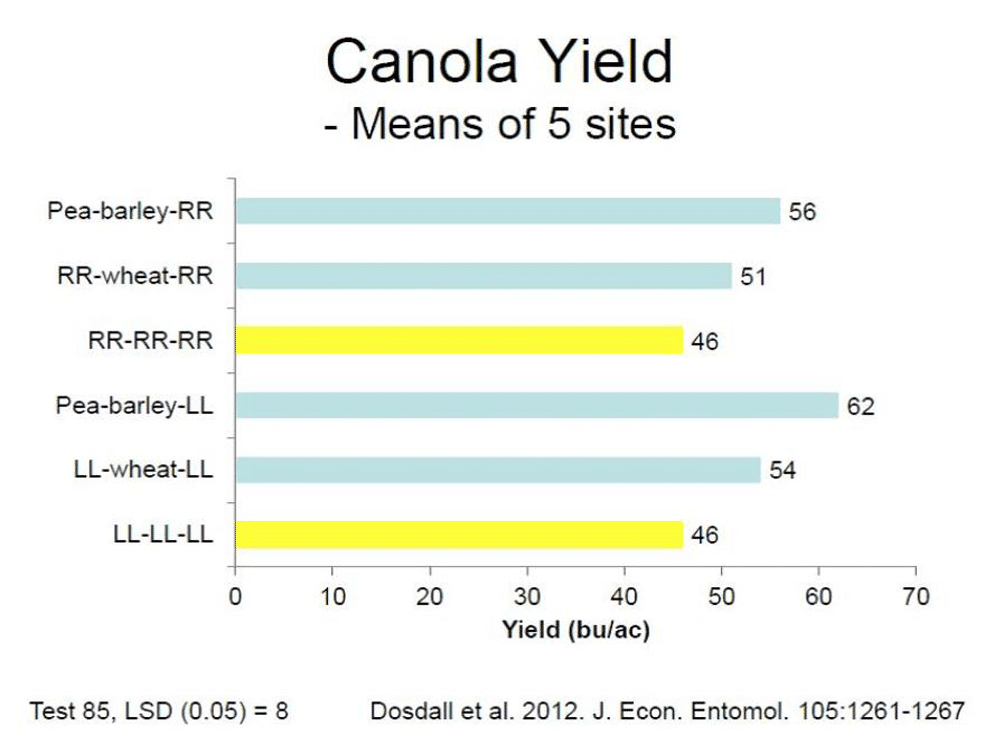
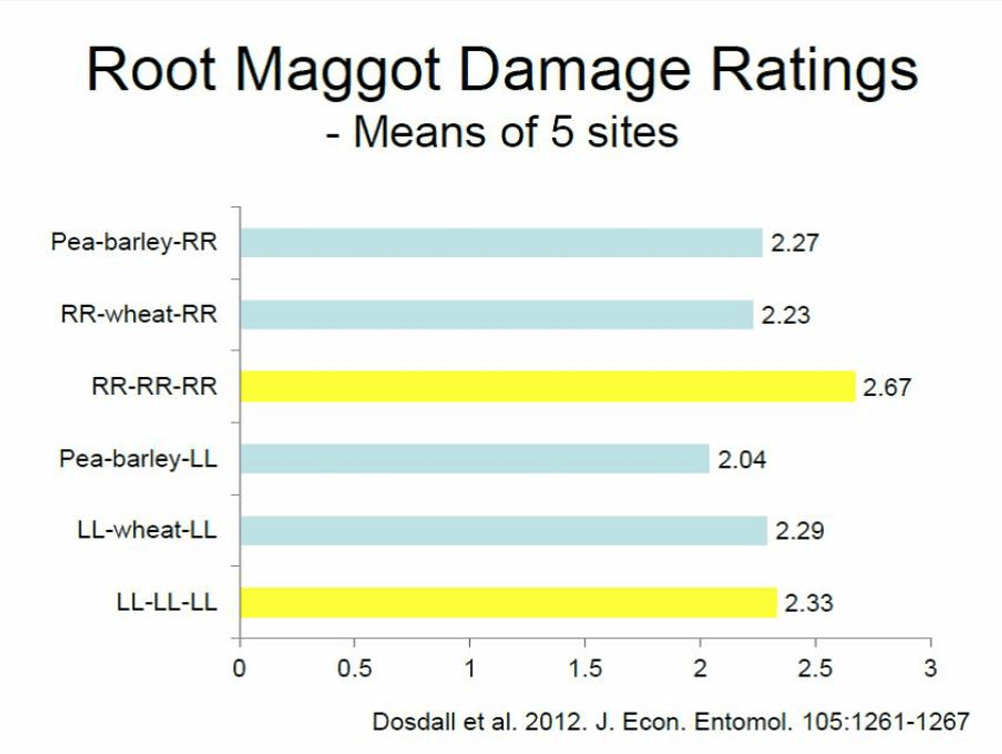
Pinning these yield losses on root maggot alone may not be entirely accurate. Disease may have also played a role in yield losses. Root maggot feeding can provide an entry point for disease, or thin stands caused by seedling disease may result in more intense root maggot feeding. Research from the mid-1990s found that the greatest root maggot damage occurred in stands planted at half the recommended seeding rate. Lower stand densities produced plants with larger basal stem diameters, and larger basal stem diameters were correlated with statistically significant increases in root maggot damage.
Tight rotations and the general increase in canola acres will also favor many other insects, especially those capable of overwintering in Canada, and may increase the selection pressure for resistance to common canola seed treatments or foliar insecticides. AAFCAgriculture and Agri-Food Canada is a department of the Government of Canada. More research found that flea beetles in Ontario were starting to develop resistance to some older foliar insecticides that had been applied.
Crop rotation impacts on fertility
Hybrid canola removes as much soil nitrate as wheat, so high yields in tight rotations with canola and wheat will result in low soil nitrate levels. Therefore, higher fertilizer rates may be required to maintain intensive canola rotations when high yields are being achieved.
One reason for lower yields in canola grown directly after canola may be due to fertility. Crop insurance data, which is based on grower-reported yields (and does not factor in any additional variables used to grow the crop), showed that the same fertility mix was used for growers seeding canola into canola stubble or into wheat stubble.
Increasing nutrient rates to match removal by the previous crop may help close the gap on crop insurance numbers, but it may not close the gap completely. AAFCAgriculture and Agri-Food Canada is a department of the Government of Canada. More rotation research tested various fertilizer rates to see if canola on canola yields could be brought up to par with yields for canola on other stubble by increasing nitrogen rates. Fertilizer helped boost yields for canola on canola, but it never closed the yield gap. Higher fertilizer rates increased the yield for canola on canola, but canola on all other stubbles also increased as nutrient rates increased. In general, canola yielded better on other stubbles no matter the fertilizer rate 4.
Crop rotation impacts on moisture
High-yielding canola uses a lot of moisture in the first two to three feet of topsoil. In years when moisture is not replenished, canola seeded after high-yielding canola (or even after wheat) will have lower yield potential.
Crop rotation impacts on weeds
Alternate crops in the rotation allow different herbicides to be used and thus can provide better overall weed control in the long term. Rotating crops and herbicides also helps to rotate herbicide groups and thus reduce the build-up of herbicide-resistant weeds.
Canola volunteers and other weeds not controlled easily in canola will become worse in a tight rotation. These weeds in particular will require a concerted effort to ensure effective control in rotation crops. Tight canola rotations couple with a limited spectrum of herbicide groups that dominate most canola acres, means increased likelihood of finding resistant biotypes and allowing them this group to increase in number within the field.
However, adding other crops to a canola-cereal rotation may increase the risk of herbicide carryover. For example, applying Odyssey to a pea crop ahead of canola is not recommended, and could increase the risk of imazethapyr damage to canola the following year. See table 1 for other examples.
Crop rotation impacts on other factors
The following may not influence canola yield potential directly, but could increase or decrease costs required to achieve the same yields.
- Shifts in pest populations. Pests that have not been a problem before may increase in number with more canola acres, increasing crop protection costs.
- Increased frequency of canola in a rotation generally means more nitrogen fertilizer needs to be applied (if high canola yield are being achieved). If this increases crop biomass and residue levels each year, soil organic matter levels could potentially be positively impacted. Conversely, if nitrogen rates do not keep up with nitrogen removal, soil organic matter reductions could result.
- If a hay or pasture crop precedes a canola crop, an earlier burndown of the hay crop (in late June or early July) could better than a later option. Later summer timing of sod-breaking may limit subsequent canola production because of depleted soil stored moisture, poor fertility and weed control, and the difficulty in preparing a good seedbed without sod clumps. Glyphosate burndown of the hay crop in late June or early July will allow for some weed control and will retain soil moisture. Breaking up the sod layer can result in lumps and a mulch layer that are not conducive to proper stand establishment. Direct seedingA seeding method where the crop is sown into the field without any previous spring tillage operations. More into sod has contributed to success, but the canola seed must be placed into moist soil in the mineral layer.
- Research around the world has documented that leachates from wheat, alfalfa and some forage grasses can be toxic to canola seedlings. Australian research has found that wheat varieties can differ in the toxicity of their residues to canola. Wheat residue phytotoxicity may partly explain occasional poor emergence and vigourSeed properties that determine the potential for rapid uniform emergence and development of normal seedlings under a wide range of field conditions. More of canola direct seeded into heavy wheat straw residue. To reduce residue toxicity, spread wheat straw and chaff evenly behind the combine, and in cases of extreme straw production, bale wheat straw. Growing semi-dwarf cereal varieties may also reduce straw load.
Managing a rotation
No single crop rotation will suit all circumstances. The choice of which crops to grow, and in what sequence, depends to a large extent on the soil and climatic conditions and management skills. In areas with adequate moisture, rotations that include cereals and broadleaf crops maintain pests at lower levels and produce consistently higher yield. An added benefit is that yields are often more stable because crops differ in their response to stress at various stages. Therefore, stress may damage one crop seriously, but others in the rotation may be less affected. Use the information in Table 1 as a guide in selecting a field for canola. Also consider crop rotation information from MASC when considering crop rotation.
The purpose and value of a three or four-year crop rotation is to maintain diversity in the cropping system. Cereals and pulses generally host different insects and disease than canola, and cereals and pulses offer other options for weed control.
If growers plan to seed canola more frequently, they should increase the level of pest management diversity by using different modes of action for weed, disease and insect management. Crop scouting and recording of issues observed should be intensified to help identify any trends that may indicate problems developing from inadequate rotation break between canola crops.
Footnotes
- Harker, K. N., O’Donovan, J. T., Turkington, T. K., Blackshaw, R. E., Lupwayi, N. Z., Smith, E. G., Johnson, E. N., Gan, Y., Kutcher, H. R., Dosdall, L. M., Peng, G. 2015. Canola rotation frequency impacts canola yield and associated pest species. Canadian Journal of Plant Science. 95:9-20.[↩]
- Peng, G., Pageau, D., Strelkov, S. E., Gossen, B.D., Hwang, S.F., Lahlali, R. 2015. A >2-year crop rotation reduces resting spores of Plasmodiophora brassicae in soil and the impact of clubroot on canola. European Journal of Agronomy. 70: 78-84.[↩]
- Dosdall, L. M., Harker, K. N., O’Donovan, J. T., Blackshaw, R. E., Kutcher, H. R., Gan, Y., Johnson, E. N. 2012. Crop Sequence Effects on Root Maggot (Diptera: Anthomyiidae: Delia spp.) Infestations in Canola. Journal of Economic Entomology. 105(4): 1261–1267.[↩]
- Harker, K.N., Hartman, M.D., Tidemann, B.D., O’Donovan, J.T., Turkington, T.K., Lupwayi, N.Z., Smith, E.G., Mohr, R.M. 2018. Attempts to rescue yield loss in continuous canola with agronomic inputs. Canadian Journal of Plant Science. 98(3): 703-716.[↩]



